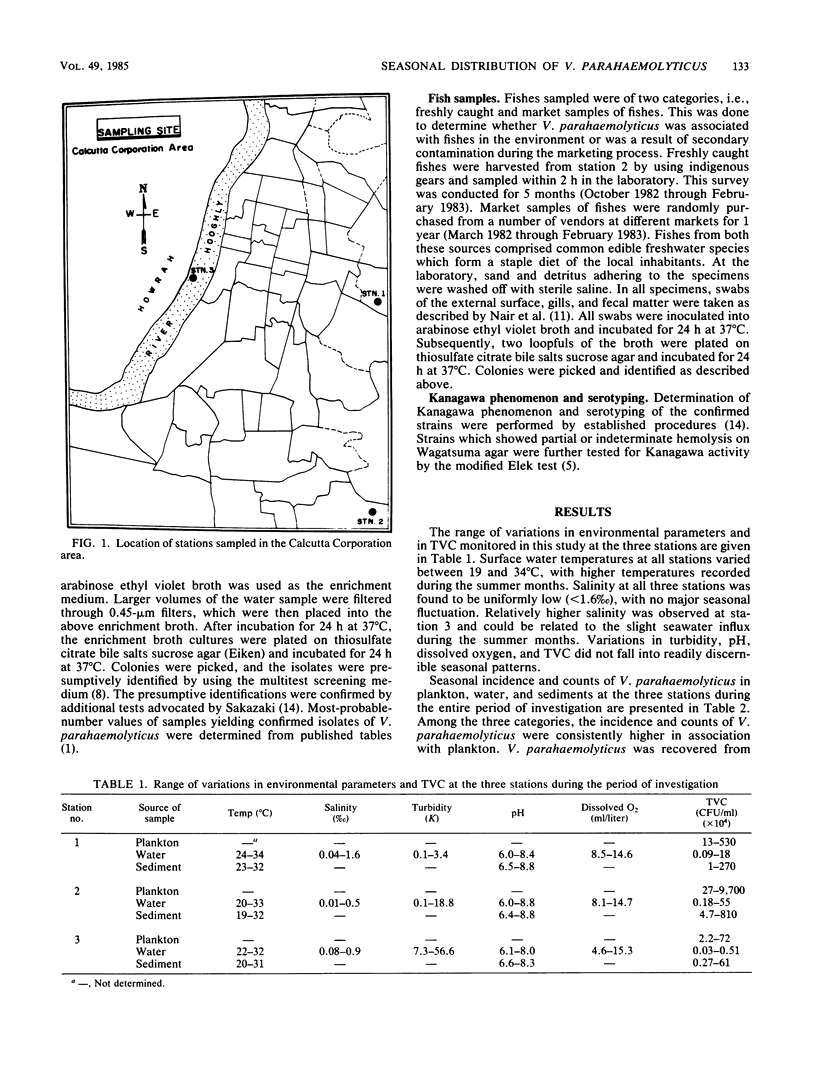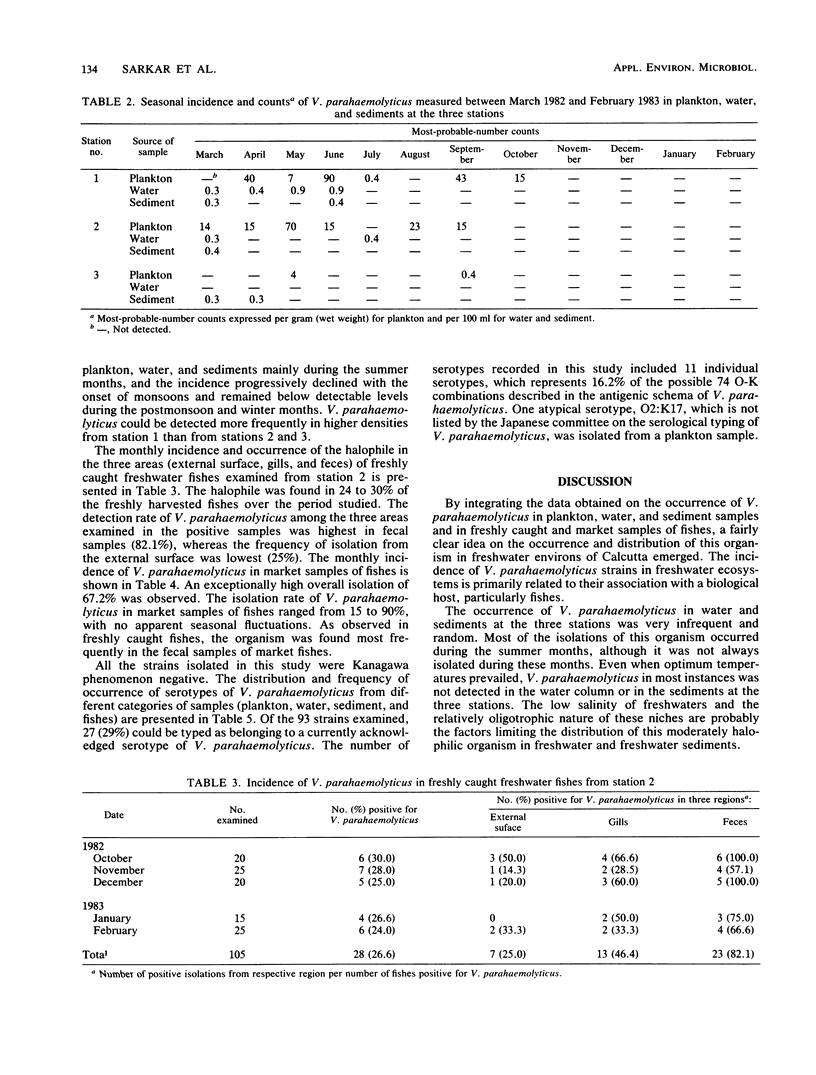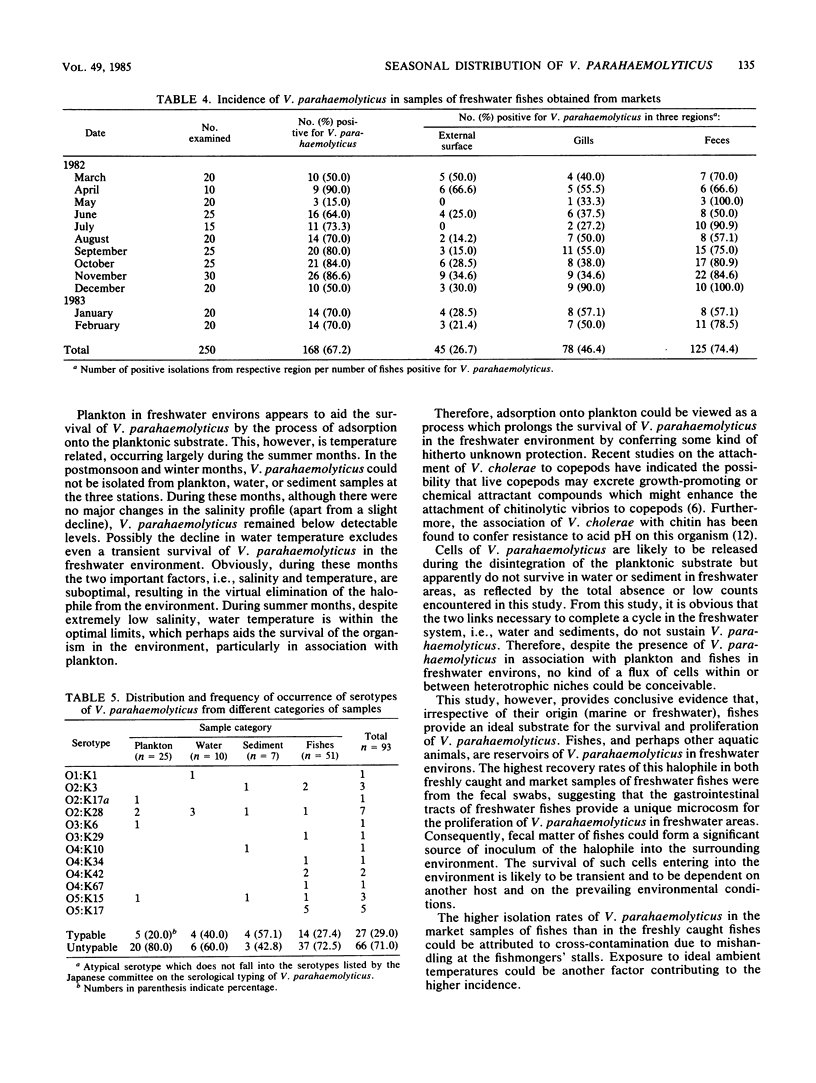Abstract
The seasonal distribution of Vibrio parahaemolyticus in freshwater environs and in association with freshwater fishes was studied in 1982 and 1983. The occurrence of this organism in water and sediments at the three sites studied was very infrequent and was restricted to the summer months, although it was not always isolated during these months. The association of V. parahaemolyticus with plankton was chiefly confined to the summer months and progressively declined with the onset of monsoons, remaining below detectable levels during the postmonsoon and winter months. The incidence and counts of V. parahaemolyticus were consistently higher in association with plankton than with water and sediment samples. V. parahaemolyticus could be recovered throughout the period of investigation from freshly caught and market samples of freshwater fishes. The highest recovery rate of this halophile from fishes was invariably from fecal samples. Most of the strains isolated in this study were untypable, and those which could be typed were predominantly serotypes encountered in the environment. All the isolates were Kanagawa negative. From this study, it could be concluded that the survival of V. parahaemolyticus in freshwater ecosystems is transient and dependent on a biological host.
Full text
PDF




Selected References
These references are in PubMed. This may not be the complete list of references from this article.
- De S. P., Banerjee M., Deb B. C., Sengupta P. G., Sil J., Sircar B. K., Sen D., Ghosh A., Pal S. C. Distribution of vibrios in Calcutta environment with particular reference to V. parahaemolyticus. Indian J Med Res. 1977 Jan;65(1):21–28. [PubMed] [Google Scholar]
- Deb B. C. Studies on Vibrio parahaemolyticus infection in Calcutta as compared to cholera infection. Prog Drug Res. 1975;19:490–502. doi: 10.1007/978-3-0348-7090-0_56. [DOI] [PubMed] [Google Scholar]
- Honda T., Chearskul S., Takeda Y., Miwatani T. Immunological methods for detection of Kanagawa phenomenon of Vibrio parahaemolyticus. J Clin Microbiol. 1980 Jun;11(6):600–603. doi: 10.1128/jcm.11.6.600-603.1980. [DOI] [PMC free article] [PubMed] [Google Scholar]
- Huq A., Small E. B., West P. A., Huq M. I., Rahman R., Colwell R. R. Ecological relationships between Vibrio cholerae and planktonic crustacean copepods. Appl Environ Microbiol. 1983 Jan;45(1):275–283. doi: 10.1128/aem.45.1.275-283.1983. [DOI] [PMC free article] [PubMed] [Google Scholar]
- Kaneko T., Colwell R. R. Ecology of Vibrio parahaemolyticus in Chesapeake Bay. J Bacteriol. 1973 Jan;113(1):24–32. doi: 10.1128/jb.113.1.24-32.1973. [DOI] [PMC free article] [PubMed] [Google Scholar]
- Lee J. V., Bashford D. J., Donovan T. J., Furniss A. L., West P. A. The incidence of Vibrio cholerae in water, animals and birds in Kent, England. J Appl Bacteriol. 1982 Apr;52(2):281–291. doi: 10.1111/j.1365-2672.1982.tb04852.x. [DOI] [PubMed] [Google Scholar]
- Nair G. B., Abraham M., Natarajan R. Distribution of Vibrio parahaemolyticus in finfish harvested from Porto Novo (S. India) environs: a seasonal study. Can J Microbiol. 1980 Nov;26(11):1264–1269. doi: 10.1139/m80-211. [DOI] [PubMed] [Google Scholar]
- Nalin D. R., Daya V., Reid A., Levine M. M., Cisneros L. Adsorption and growth of Vibrio cholerae on chitin. Infect Immun. 1979 Aug;25(2):768–770. doi: 10.1128/iai.25.2.768-770.1979. [DOI] [PMC free article] [PubMed] [Google Scholar]
- Sakazaki R., Tamura K., Prescott L. M., Bencic Z., Sanyal S. C., Sinha R. Bacteriological examination of diarrheal stools in Calcutta. Indian J Med Res. 1971 Jul;59(7):1025–1034. [PubMed] [Google Scholar]
- Sarkar B. L., Nair G. B., Sircar B. K., Pal S. C. Incidence and level of Vibrio parahaemolyticus associated with freshwater plankton. Appl Environ Microbiol. 1983 Jul;46(1):288–290. doi: 10.1128/aem.46.1.288-290.1983. [DOI] [PMC free article] [PubMed] [Google Scholar]


